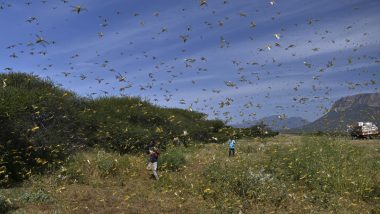Mumbai, May 26: A swarm of desert locusts has entered the eastern part of Maharashtra where district and agriculture department personnel have initiated chemical spraying on crops and vegetation to save them from the migratory pests, said officials on Monday.
Primary reports indicated that in the last couple of days, four to five villages in the Vidarbha region have come under attack from the locusts, known for feasting on all sorts of plants and standing crops.
Also Read | Coronavirus Deaths in Mumbai Cross 1,000-Mark, COVID-19 Tally Reaches 31,789.
Joint director of agriculture Ravindra Bhosale told PTI, The swarm of desert locusts entered the state from Amravati district. It then went to Wardha and now it is in Nagpurs Katol tehsil." Locust Swarm Attacks North India: Scary Pics and Videos of 'Tiddi Dal' From Rajasthan, Madhya Pradesh and Uttar Pradesh Worry Farmers.
A team from the regional centre of the Central Integrated Pest Management Centre has started spraying chemicals on crops and plants near the Jalalkheda bypass where the insects have been located, he said.
"Central agencies in this field had alerted us about the locust attack and necessary information had been passed on to villagers as well," Bhosale said.
"A swarm does not travel in the night. The migratory pests travel during the day time and fly as per the wind direction," the officer said.
"Locusts are very dangerous to all types of vegetation. They feed on green leaves and known for devouring crops spread across on acres of land, he said.
I am personally monitoring the chemical spraying as we would using some 1,200 litres of water with insecticides, the official said.
Earlier, locust attacks were reported from neighbouring Gujarat and Madhya Pradesh.
According to the Food and Agriculture Organisation (FAO), an agency of the United Nations, the desert locust is considered the most dangerous of all migratory pest species in the world.
It threatens peoples livelihoods, food security, the environment and economic development, the FAO has said.
(This is an unedited and auto-generated story from Syndicated News feed, LatestLY Staff may not have modified or edited the content body)













 Quickly
Quickly




















